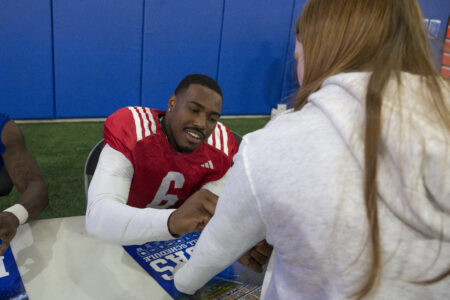Look familiar? Younger Sands embraces underdog role just like dad

Kansas running back Deshaun Sands (36) grabs a pass in the spring game on April 24 at Memorial Stadium. Sands, listed as second-string on the depth chart at running back, will attempt to impact the Jayhawks like his father did a generation ago.
Vertically challenged and not capable of getting to the tape first in a straight-ahead sprint against most featured Div. I running backs, Kansas University red-shirt freshman running back Deshaun Sands is the pitching prospect just up from Triple A labeled marginal because his fastball and body type are a tad on the short side, the guy who doesn’t get as long a trial as the first-round draft choice who short-circuits radar guns.
A generation before him, Tony Sands was a similar underdog, though faster than his son. At 5-foot-6, the older Sands didn’t fit the profile either, but was given a chance, and he ran so hard with it he blew up not only his school’s records, but set NCAA marks of 58 carries and 396 rushing yards in a single game.
Could it happen again? Could another undersized Sands defy the odds for KU again?
The easy answer is no. Even bigger, faster defenders stock big-time defenses than when Tony Sands (1988-91) earned 1991 Big Eight Conference Offensive Player of the Year honors and tied or set 17 Kansas rushing or scoring records.
It pays to remember the easy answer isn’t always the right one. Tony proved that.
Even Deshaun Sands, a 5-7, 190-pound shifty runner from Sunrise, Fla., wonders how in the world his father was so hard to bring down.
“My brother and I, when we were young, used to look at (his highlight film) all the time,” Deshaun said. “When I first looked at it, I was like, ‘I don’t know how he did it.’ Watching him gives me motivation to do the same thing.”
Ranked second on KU’s running-back depth chart, the younger Sands leaves teammates asking the same questions that used to be asked about his father.
“Me and my teammates talk about it all the time,” Deshaun said. “They’ll say, ‘It’s amazing you’re still here playing.’ It’s all a mind thing. If you have it in your mind, you can play.”
But the natural first thought of evaluators watching a player that small always is going to drip skepticism. That’s just the way the mind works.
Tony Sands lives in South Florida, trains professional athletes, evaluates high school football talent and is the prep football expert on the radio show of his uncle, former Dallas Cowboys wide receiver Michael Irvin, younger brother to Tony’s mother.
Tony shared with his son what put him over the top.
“I tell him my determination was my most valuable asset because I was so determined to prove people wrong, people who said I couldn’t do this, I couldn’t do that,” Tony said by phone from Florida. “That’s what drove me to be successful. He’s going to run into that. Just make sure you understand you can’t be mediocre. You can’t rely on what you did yesterday. You always have to climb and climb and climb.”
“Tuxedo” Tony Sands was so named because he wore a tux to games. Deshaun said Tuesday he owns one but has not yet decided whether he’ll continue his father’s tradition. Here’s hoping he does. It would add a lot of spice to a pregame football atmosphere that became lively again when former KU athletic director Al Bohl brought back tailgating. The hard-core fans could arrive early enough to spot the running back in tails.
“I’m thinking about it,” Deshaun said. “I’m thinking about it. I’ve owned one since I was in high school.”
Deshaun said his father told him he wore a tuxedo to games, but never told him why.
So why did Tony decide to become the best-dressed player in college football?
“I was around Michael Irvin and watched him create a brand for himself,” Tony said of his celebrity uncle. “The Playmaker. I watched him use that brand name for himself, and it stayed with him. I told myself I wanted to create a brand, not knowing how far it would go. I enjoyed the success that came with that brand.”
Deshaun does not grow defensive talking about his size. Instead, he embraces the advantages it brings.
“I’m low to the ground, and being low to the ground helps me because defenders try to tackle me, and I’m able to get lower than them so they can’t get a full tackle on me,” he said. “It’s easy to be a short guy. I try to get to the defenders’ knees, so he’s diving at me and I slip under him. It happens quite a bit.”
Deshaun Sands knows his college football.
“I guess a lot of schools now are starting to find out small backs are not a bad thing,” he said. “Some of the top backs are small backs right now, like (West Virginia’s) Noel Devine, Chris Rainey and Jeff Demps (both of Florida).”
He said he never has played in front of a crowd bigger than 200 or 300.
“It’s going to be like a gladiator war,” Sands said of Saturday’s 6 p.m. kickoff against North Dakota State. “You’ve got everybody around you making noise, vibrating at your feet. It’s going to be a nice feeling.”
What an interesting twist Sands could put on this season if he has what it takes to bring the crowd to its feet.







